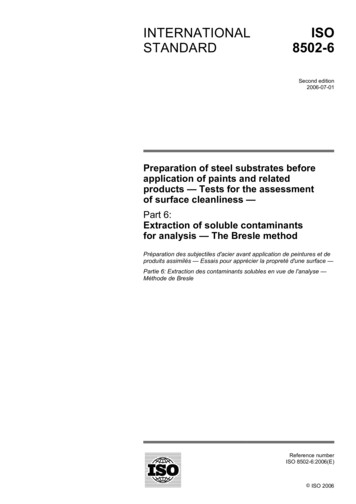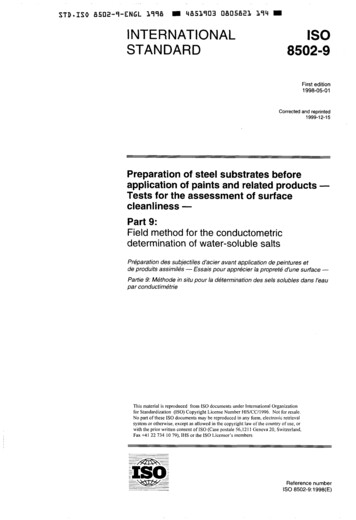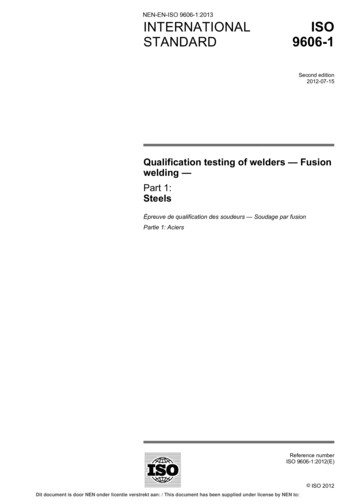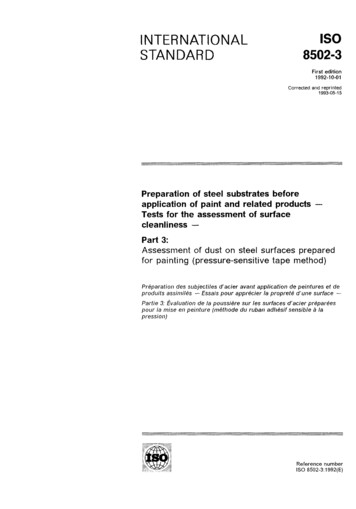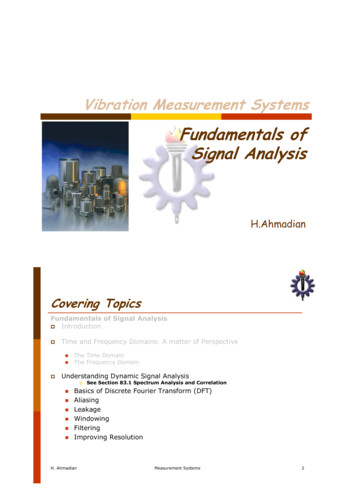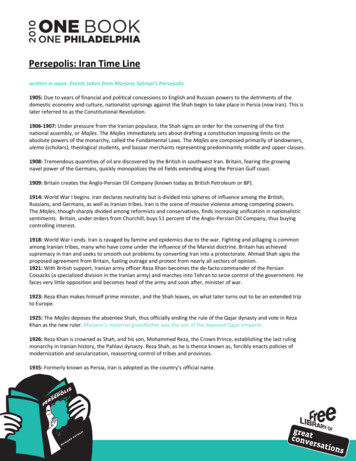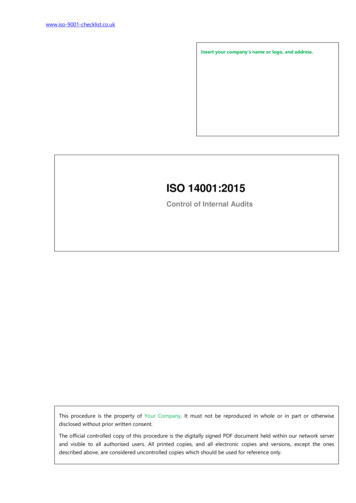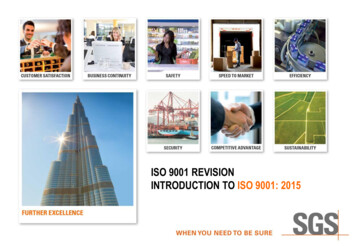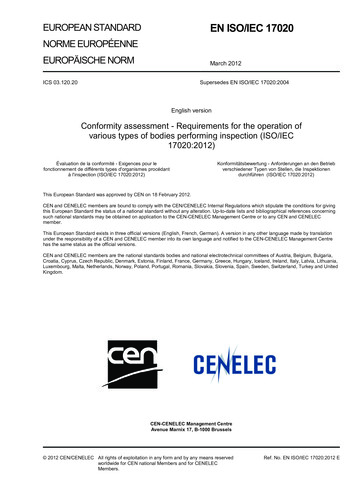
Transcription
EN ISO/IEC 17020EUROPEAN STANDARDNORME EUROPÉENNELicensed copy: Bradford University, University of Bradford, Version correct as of 03/04/2012 06:06, (c) The British Standards Institution 2012EUROPÄISCHE NORMMarch 2012ICS 03.120.20Supersedes EN ISO/IEC 17020:2004English versionConformity assessment - Requirements for the operation ofvarious types of bodies performing inspection (ISO/IEC17020:2012)Évaluation de la conformité - Exigences pour lefonctionnement de différents types d'organismes procédantà l'inspection (ISO/IEC 17020:2012)Konformitätsbewertung - Anforderungen an den Betriebverschiedener Typen von Stellen, die Inspektionendurchführen (ISO/IEC 17020:2012)This European Standard was approved by CEN on 18 February 2012.CEN and CENELEC members are bound to comply with the CEN/CENELEC Internal Regulations which stipulate the conditions for givingthis European Standard the status of a national standard without any alteration. Up-to-date lists and bibliographical references concerningsuch national standards may be obtained on application to the CEN-CENELEC Management Centre or to any CEN and CENELECmember.This European Standard exists in three official versions (English, French, German). A version in any other language made by translationunder the responsibility of a CEN and CENELEC member into its own language and notified to the CEN-CENELEC Management Centrehas the same status as the official versions.CEN and CENELEC members are the national standards bodies and national electrotechnical committees of Austria, Belgium, Bulgaria,Croatia, Cyprus, Czech Republic, Denmark, Estonia, Finland, France, Germany, Greece, Hungary, Iceland, Ireland, Italy, Latvia, Lithuania,Luxembourg, Malta, Netherlands, Norway, Poland, Portugal, Romania, Slovakia, Slovenia, Spain, Sweden, Switzerland, Turkey and UnitedKingdom.CEN-CENELEC Management CentreAvenue Marnix 17, B-1000 Brussels 2012 CEN/CENELEC All rights of exploitation in any form and by any means reservedworldwide for CEN national Members and for CENELECMembers.Ref. No. EN ISO/IEC 17020:2012 E
Licensed copy: Bradford University, University of Bradford, Version correct as of 03/04/2012 06:06, (c) The British Standards Institution 2012BS EN ISO/IEC 17020:2012EN ISO/IEC 17020:2012 (E)ForewordThis document (EN ISO/IEC 17020:2012) has been prepared by Technical Committee ISO/CASCO“Committee on conformity assessment” in collaboration with Technical Committee CEN/CLC/TC 1 “Criteria forconformity assessment bodies” the secretariat of which is held by BSI.This European Standard shall be given the status of a national standard, either by publication of an identicaltext or by endorsement, at the latest by September 2012, and conflicting national standards shall bewithdrawn at the latest by September 2012.Attention is drawn to the possibility that some of the elements of this document may be the subject of patentrights. CEN [and/or CENELEC] shall not be held responsible for identifying any or all such patent rights.This document supersedes EN ISO/IEC 17020:2004.According to the CEN/CENELEC Internal Regulations, the national standards organizations of the followingcountries are bound to implement this European Standard: Austria, Belgium, Bulgaria, Croatia, Cyprus, CzechRepublic, Denmark, Estonia, Finland, France, Germany, Greece, Hungary, Iceland, Ireland, Italy, Latvia,Lithuania, Luxembourg, Malta, Netherlands, Norway, Poland, Portugal, Romania, Slovakia, Slovenia, Spain,Sweden, Switzerland, Turkey and the United Kingdom.Endorsement noticeThe text of ISO/IEC 17020:2012 has been approved by CEN as a EN ISO/IEC 17020:2012 without anymodification.3
Licensed copy: Bradford University, University of Bradford, Version correct as of 03/04/2012 06:06, (c) The British Standards Institution 2012BS EN ISO/IEC 17020:2012ISO/IEC 17020:2012(E)ContentsPageForeword . ivIntroduction . v1Scope . 12Normative references . 13Terms and definitions . 144.14.2General requirements . 3Impartiality and independence . 3Confidentiality. 455.15.2Structural requirements . 4Administrative requirements . 4Organization and management . 466.16.26.3Resource requirements . 5Personnel . 5Facilities and equipment. 6Subcontracting . 877.17.27.37.47.57.6Process requirements . 8Inspection methods and procedures . 8Handling inspection items and samples . 9Inspection records . 9Inspection reports and inspection certificates . 9Complaints and appeals . 10Complaints and appeals process . 1088.18.28.38.48.58.68.78.8Management system requirements . 11Options . 11Management system documentation (Option A) . 11Control of documents (Option A) . 12Control of records (Option A) . 12Management review (Option A) . 13Internal audits (Option A) . 13Corrective actions (Option A) . 14Preventive actions (Option A) . 14Annex A (normative) Independence requirements for inspection bodies . 15Annex B (informative) Optional elements of inspection reports and certificates . 17Bibliography . 18 ISO 2012 – All rights reservediii
Licensed copy: Bradford University, University of Bradford, Version correct as of 03/04/2012 06:06, (c) The British Standards Institution 2012BS EN ISO/IEC 17020:2012ISO/IEC 17020:2012(E)ForewordISO (the International Organization for Standardization) and IEC (the International ElectrotechnicalCommission) form the specialized system for worldwide standardization. National bodies that are members ofISO or IEC participate in the development of International Standards through technical committeesestablished by the respective organization to deal with particular fields of technical activity. ISO and IECtechnical committees collaborate in fields of mutual interest. Other international organizations, governmentaland non-governmental, in liaison with ISO and IEC, also take part in the work. In the field of conformityassessment, the ISO Committee on conformity assessment (CASCO) is responsible for the development ofInternational Standards and Guides.International Standards are drafted in accordance with the rules given in the ISO/IEC Directives, Part 2.Draft International Standards are circulated to the national bodies for voting. Publication as an InternationalStandard requires approval by at least 75 % of the national bodies casting a vote.Attention is drawn to the possibility that some of the elements of this document may be the subject of patentrights. ISO shall not be held responsible for identifying any or all such patent rights.ISO/IEC 17020 was prepared by the ISO Committee on conformity assessment (CASCO).It was circulated for voting to the national bodies of both ISO and IEC, and was approved by bothorganizations.This second edition cancels and replaces the first edition (ISO/IEC 17020:1998), which has been technicallyrevised.iv ISO 2012 – All rights reserved
Licensed copy: Bradford University, University of Bradford, Version correct as of 03/04/2012 06:06, (c) The British Standards Institution 2012BS EN ISO/IEC 17020:2012ISO/IEC 17020:2012(E)IntroductionThis International Standard has been drawn up with the objective of promoting confidence in bodiesperforming inspection.Inspection bodies carry out assessments on behalf of private clients, their parent organizations, or authorities,with the objective of providing information about the conformity of inspected items with regulations, standards,specifications, inspection schemes or contracts. Inspection parameters include matters of quantity, quality,safety, fitness for purpose, and continued safety compliance of installations or systems in operation. Thegeneral requirements with which these bodies are required to comply in order that their services are acceptedby clients and by supervisory authorities are harmonized in this International Standard.This International Standard covers the activities of inspection bodies whose work can include the examinationof materials, products, installations, plants, processes, work procedures or services, and the determination oftheir conformity with requirements and the subsequent reporting of results of these activities to clients and,when required, to authorities. Inspection can concern all stages during the lifetime of these items, includingthe design stage. Such work normally requires the exercise of professional judgement in performinginspection, in particular when assessing conformity with general requirements.This International Standard can be used as a requirements document for accreditation or peer assessment orother assessments.This set of requirements can be interpreted when applied to particular sectors.Inspection activities can overlap with testing and certification activities where these activities have commoncharacteristics. However, an important difference is that many types of inspection involve professionaljudgement to determine acceptability against general requirements, for which reason the inspection bodyneeds the necessary competence to perform the task.Inspection can be an activity embedded in a larger process. For example, inspection can be used as asurveillance activity in a product certification scheme. Inspection can be an activity that precedes maintenanceor simply provides information about the inspected item with no determination of conformity with requirements.In such cases, further interpretation might be needed.The categorization of inspection bodies as type A, B or C is essentially a measure of their independence.Demonstrable independence of an inspection body can strengthen the confidence of the inspection body'sclients with respect to the body's ability to carry out inspection work with impartiality.In this International Standard, the following verbal forms are used: “shall” indicates a requirement; “should” indicates a recommendation; “may” indicates a permission; “can” indicates a possibility or a capability. ISO 2012 – All rights reservedv
Licensed copy: Bradford University, University of Bradford, Version correct as of 03/04/2012 06:06, (c) The British Standards Institution 2012BS EN ISO/IEC 17020:2012
BS EN ISO/IEC 17020:2012Licensed copy: Bradford University, University of Bradford, Version correct as of 03/04/2
ISO/IEC 17020 was prepared by the ISO Committee on conformity assessment (CASCO). It was circulated for voting to the national bodies of both ISO and IEC, and was approved by both organizations. This second edition cancels and replaces the first edition (ISO/IEC 17020:1998), which has been technically Licensed copy: Bradford University, University of Bradford, Version correct as of

